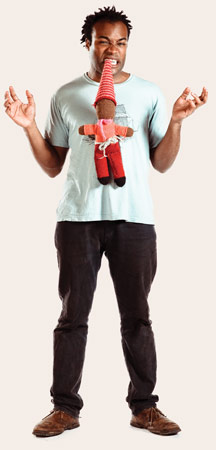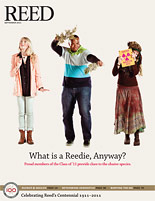
IRIS login | Reed College home Volume 90, No. 3: September 2011
What is a Reedie, Anyway? (continued)
Photos by Matt D’Annunzio

“This little fellow is a Waldorf gnome. Asha and Amir, my younger brother and sister, had gnomes as a part of their education. I brought this gnome to Reed with me to remind me of them. I’ve had it since freshman year.”
Salim Moore
Art
Hometown: Pasadena, California
Thesis: Out of the Cauldron: Witchcraft in the Art of Hans Baldung Grien and David Teniers the Younger
Adviser: William Diebold
What it’s about: Exploring how the figure of the witch developed in early modern Europe.
What it’s really about: How seeing is believing.
Who I was when I got to Reed: I was a total greenhorn. In high school, I pretty much played Dungeons and Dragons and video games. When I came to Reed, the floodgates opened. I had to hit the ground running.
Influential book: The Mabinogion, a collection of medieval Welsh myths.
Favorite spots: Prexy and the canyon. They both have beautiful music.
Cool stuff I did: Discovered how to brew beer, speak the language of dance, play the accordion, and spin fire. Performed with YAM, an improv comedy troupe that never uses the same name twice. (Yaks And Mandolins, Your Aunt Mary, etc.) KRRC. Drum Kore. Worked with the roughest and toughest tumblers of them all—canyon crew!
Random thoughts: In addition to financial aid, I also won a $5,000 scholarship through the Douglas Williams Fencing Tournament. Swordplay builds character and teaches you discipline. Financial aid is a great way in which the Reed community manifests itself. One of the best parts about being at Reed is you see the community from the ground up. I was giving a tour this morning and one of the prospects asked me, “Is everyone at Reed on a first-name basis?” and I said, “Yeah.”
How Reed changed me: Sometimes I think of my Reed experience as a boat. I am a sailor and Reed is the ship. Reed taught me how to think about the world in other ways. Some of that happened inside the classroom, some of it happened outside the classroom. I learned how to be comfortable in my own shoes, walk the walk, and talk the talk.
What’s next: Teaching art.
Thesis close-up:
Imagination and Witchcraft
My thesis looks at how the imagination works and how artists convince people to believe in things they can’t see. In the case of witchcraft, you have Hans Baldung Grien, who was a student of Dürer. In their prints, they have these images of witches riding backwards on goats, summoning hailstorms, cooking sausages, doing all these bad things. (Cooking sausages is the worst, actually.) Of course, no one’s ever seen a witch flying through the sky or riding on a goat. But back in 1510, when an artist presents that vision, it’s like a photograph in the New York Times. It’s definitive. Viewers have their beliefs affirmed in what they see. “Yes, I’ve heard the stories about witches eating babies and now I see it to be real.”
My thesis also focuses on gender. Originally, witches could be male or femail. After the publication of Malleus Maleficarum, which declared that witches were women, the imagery shifted. Grien was one of the first artists to use the cauldron as a symbol for a woman’s body. A lot of time you’ll see witches casting hailstorms out of cauldrons or conjuring vaporous mists, which were understood to represent menses. Artists took brooms and cooking forks—domestic objects that women used around the house—to show how witchcraft was female. When people saw the images they said, “Okay, this is what an evil witch looks like.” Though witchcraft may seem outdated, it still has relevance. When you read into the images you begin to understand how the imagination affects both the future and the past. For example, science fiction looks forward to things that don’t exist. Sometimes we have to imagine a better world before we can create it.—SM


LATEST COMMENTS
steve-jobs-1976 I knew Steve Jobs when he was on the second floor of Quincy. (Fall...
Utnapishtim - 2 weeks ago
Prof. Mason Drukman [political science 1964–70] This is gold, pure gold. God bless, Prof. Drukman.
puredog - 1 month ago
virginia-davis-1965 Such a good friend & compatriot in the day of Satyricon...
czarchasm - 4 months ago
John Peara Baba 1990 John died of a broken heart from losing his mom and then his...
kodachrome - 7 months ago
Carol Sawyer 1962 Who wrote this obit? I'm writing something about Carol Sawyer...
MsLaurie Pepper - 8 months ago
William W. Wissman MAT 1969 ...and THREE sisters. Sabra, the oldest, Mary, the middle, and...
riclf - 10 months ago